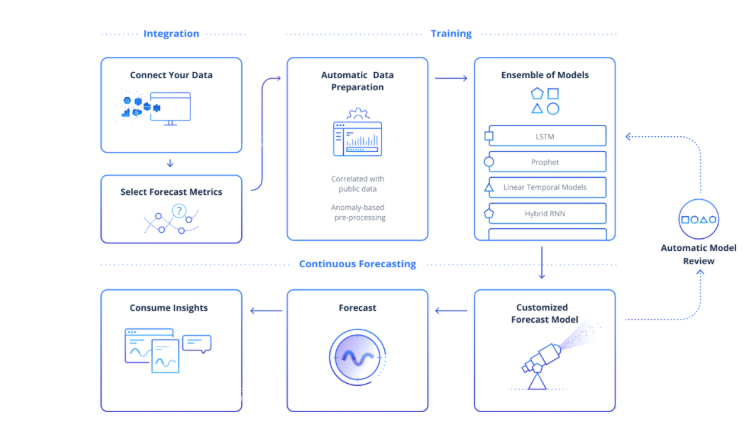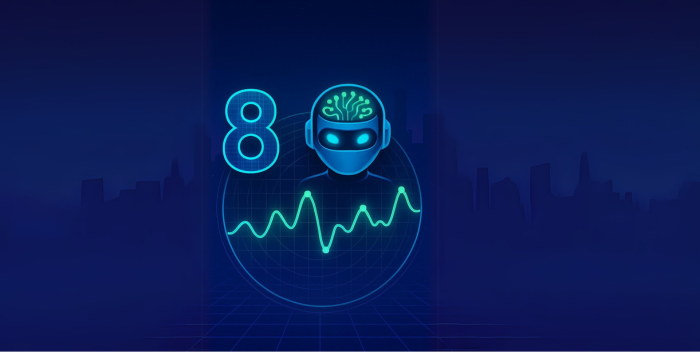Regardless of your industry, the countless metrics and KPIs at your disposal is currency you can use to purchase more accurate business forecasting. Machine learning is autonomously powering these forecasts, because of its superior abilities to be accurate, scale, adapt to fluctuating behavior and deliver results in real time.
In this article:
- Background
- What is Business Forecasting?
- Business Forecasting with Machine Learning
- How does It work?
- Use Cases of AI-Based Business Forecasting
- Summary: Business Forecasting with AI
Background
As many companies have come to realize, traditional statistical modeling techniques such as time series forecasting are not well suited to handle the number of metrics and KPIs available for forecasting, which often number in the thousands.
These traditional statistical models may be able to take in, for example, the company’s revenue data for the past ten years in order to generate a static forecast for the coming year, but in today’s business world that simply doesn’t provide the accuracy that’s required.
What many companies have realized is that there’s immense value in combining tens, or even thousands of metrics in order to make time series forecasts. For example, if you’re forecasting revenue, there’s often value in including customer experience metrics for forecasting such as the conversion rate, churn rate and so on.
As you may know, traditional time series forecasting can’t be fed more than a few metrics for forecasting. Instead, as we’ll discuss in this guide, many companies turned to AI and machine learning for business forecasting as it can monitor, analyze and adapt to changes in big data, and they can also find correlations in thousands of seemingly disparate metrics.
What is Business Forecasting?
Before we get into the application of AI and machine learning, let’s first define business forecasting.
Business forecasting is the process of using time series data in order to estimate and predict future developments in areas such as sales, revenue and demand for resources and inventory. In particular, business forecasting is generally divided into two main categories:
- Demand Forecasting: Forecasting demand for resources such as inventory and staff is crucial for making sure demand is being met. An example of a demand forecast for a retail company would be asking the following question: “How should I plan the inventory needed for each location in the next quarter, month or week?” As you may know, more accurate inventory planning for each location reduces inventory cost, and improves customer experience.
- Growth Forecasting: Predictive growth modeling is a crucial part for more accurate corporate planning. In particular, with an accurate forecast of future growth, you can make better budgeting decisions, allocate resources more efficiently, and infer exactly what needs to be done to meet your targets. An example of a growth forecast is asking the question: “What will be the revenue at the end of this quarter?” As you can imagine, revenue forecasting involves analyzing historical data using countless metrics such as geographic inventory, customer withdrawal patterns and much more.
Now that we know what business forecasting is, let’s look at how machine learning can be used to improve the accuracy and efficiency of forecasts.
Business Forecasting with Machine Learning
As mentioned, one of the main advantages of machine learning for business forecasting is that you can take thousands of metrics that you have at your disposal and consider each one for the prediction at hand to plan far more accurately than with manual methods.
Not only can AI-based forecasting provide the accuracy you need by taking into account all these factors, but a turn-key solution is also fully autonomous, continuously reconfiguring projections as patterns change to better inform your decisions.
As mentioned, the key difference between traditional business forecasting and a machine learning-based solution is that AI can be fed as many business metrics and KPIs as you have at your disposal. It doesn’t matter if you have 100 or 100,000 factors that could influence your forecast, machine learning can find patterns and correlations in data that a traditional (or human) system simply would never be able to find.
Not only can AI-based forecasting provide the accuracy you need by taking into account all these factors, but a turn-key solution is also fully autonomous, continuously reconfiguring projections as patterns change to better inform your decisions.
How does It work?
An AI-based forecasting solution uses an ensemble of machine learning algorithms to optimize forecasts. The system then selects a model that’s uniquely suited for the particular business metric that you’re forecasting.
A turn-key solution does all this without manual input — it independently manages the entire machine learning pipeline from training the model and tuning hyperparameters, all the way to deploying the forecasting model in production. In particular, here is a step-by-step overview of the process that an AI-based forecasting system uses:
- Connect the data: This involves providing your internal data sources and any external data that may be beneficial to the forecast.
- Select forecast metrics: The customer then selects which metrics to forecast and what the time horizon should be.
- Perform automatic data preparation: Data preparation can be a significant undertaking. With an automated data preparation solution, you’re able to preprocess historical data with various algorithms to remove factors that aren’t relevant to the forecast.
- Train the machine learning model: Training the model involves sending the preprocessed data to a variety of algorithms for forecasting and then testing the accuracy of each result.
- Create a customized model: Based on the accuracy of each model, only the highest performing ones are selected to create a custom model for the forecasting task at hand.
- Review the custom model: After the initial customized model is created, we then conduct frequent reviews of the accuracy and repeat the previous training steps if necessary.
- Make a forecast: Next, we use the custom model and the data provided to make a real-time forecast and the results are stored for future use.
- Consume the forecast insights: Finally, the forecasts are displayed in dashboards, reports or alerts so that anyone can make use of them regardless of their technical expertise.
Now that we have a high-level overview of machine learning for business forecasting, let’s review actual use cases.
Use Cases of AI-Based Business Forecasting
As mentioned, the two main categories of business forecasting include demand and growth forecasting. Here are several examples of how different businesses are seeing immense value from AI business forecasting.
Demand Forecasting in Fintech
Fintech has been an early adopter of AI, and a growing number of fintech companies are getting into the business of facilitating transactions, especially for eCommerce. Since many of these companies operate in multiple countries, there is a high degree of complexity related to managing fluctuating currencies and exchange rates. As a result, the need for accurately forecasting the demand for each currency is critical for corporate planning.
To solve this business challenge, companies have turned to AI to take advantage of the aforementioned accuracy, scale, and adaptability of AI-based forecasting. In particular, AI-based demand forecasts can respond to changing market conditions and consumer behavior in real-time, allowing the companies that use them to make better business decisions based on these insights before the competition.
In the context of Fintech, improved demand forecasting enables companies to have the right amount of supply to meet the demands of customers withdrawing from their accounts, without tying up too much cash at any given time.
Growth Forecasting in Telco
Forecasting growth is essential to help companies manage their short and long-term business objectives. One common use case is forecasting the number of customers that are expected to cancel their subscription each quarter, otherwise known as customer churn. For example, in the telecommunications industry, one company chose to use AI instead of traditional forecasting techniques and were able to consider many more influencing factors that indicate a customer is likely to cancel their service.
The telco company learned that they could use external data from their competitors such as events and marketing campaigns, which led to a much higher degree of accuracy for its own churn forecasts. As a result of being an early AI adopter, the company was able to take these insights and make their own marketing and business plans to retain existing customers.
Summary: Business Forecasting with AI
As we’ve discussed, whether it’s for growth or demand, business forecasting is a critical part of corporate planning.
While many companies have traditionally used statistical techniques such as univariate and multivariate models, the reality is that these models simply can’t handle the number of business metrics and KPIs that companies have available for forecasting.
Instead, an AI-based solution can take in as many factors that are available and produce a significantly more accurate forecast by identifying patterns and correlations that would have otherwise gone unnoticed.
Not only can an AI-based solution take in all these factors, but it also requires minimal input from the user. With just the metrics to be considered, the time horizon and desired forecast, a turn-key AI-based forecasting solution can handle the entire pipeline from data preprocessing all the way to consuming the insights.
As a result, regardless of the industry or what KPI is being forecasted, it seems that many companies are starting to understand that the accuracy of AI-based business forecasting gives early adopters a considerable advantage over the competition.





